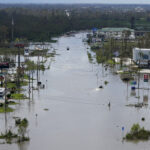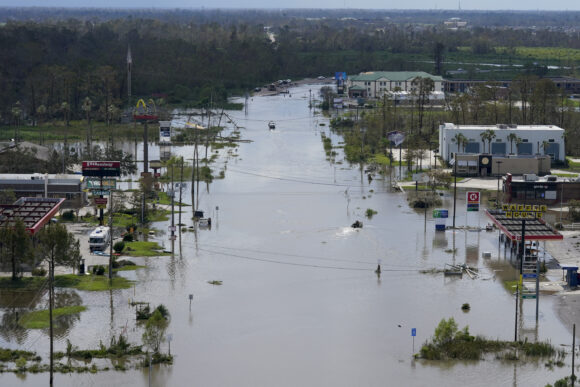U.S. senators from Florida, Louisiana, Mississippi and Texas have introduced legislation to delay the roll out of new risk rating methodology from the National Flood Insurance Program (NFIP) they say would result in flood insurance rate hikes for residents in their states.
According to a message released by Louisiana Republican Senator Bill Cassidy M.D. (R-LA), he has joined Senators Marco Rubio (R-FL), Cindy Hyde-Smith (R-MS), and John Cornyn (R-TX) in introducing the NFIP Risk Rating 2.0 Delay Act of 2021. The legislation would require the Federal Emergency Management Agency (FEMA), which manages the NFIP, to delay that agency’s Risk Rating 2.0 rollout until Sept. 30, 2022.
According to Sen. Cassidy’s press release, the delay would prevent premium hikes from going into effect for NFIP policyholders, and would give lawmakers time to develop meaningful, sustainable reforms to the flood insurance program.
“These aren’t rich people Risk Rating 2.0 will hurt,” Sen. Cassidy said in a statement. “These are middle-income and working families who depend on the NFIP to recover after disaster. This bill does what the administration refuses to do: delay Risk Rating 2.0.”
“Congress never passed a bill requiring that FEMA implement Risk Rating 2.0. It was a decision made by FEMA which gives President Biden and his administration the ability to stop it from going into effect without action from Congress,” Cassidy’s press release states.
Cassidy and Sen. Bob Menendez (D-NJ), along with a bipartisan group of colleagues, recently urged FEMA to delay Risk Rating 2.0, referring to the destruction caused by Hurricane Ida, which ravaged parts of Louisiana and New Jersey. The deaths of at least 89 individuals, including 29 in Louisiana, have been attributed to Ida, which caused tens of billions of dollars in property damage.
It Doesn’t Take a Hurricane to Cause a Flood
According to the senators, Risk Rating 2.0 will leave flood providers overburdened with the added responsibility of learning a new, unfamiliar and untested rating system.

The rollout of Risk Rating 2.0 is slated to begin Oct. 1. It’s the first time FEMA has revised its pricing methodology for flood risks since the 1970s. Traditionally, rates for the NFIP “have been predominantly based on relatively static measurements, emphasizing a property’s elevation within a zone on a Flood Insurance Rate Map (FIRM),” FEMA said in a message on its website.
Risk Rating 2.0 will rollout in two phases. In phase one, beginning on Oct. 1, 2021, new policies, as well as policies eligible for renewal on that date, will be subject to the new rating methodology, FEMA said. In phase two, policies renewing on or after April 1, 2022, will be issued under Risk Rating 2.0 methodology.
FEMA’s new rating methodology will increase flood insurance rates for 3.8 million homeowners, according to an analysis by ValuePenguin.com. Not every NFIP policyholder will see a rate increase, however. Some may experience no change in rates while the cost for flood insurance will decrease for some 1.2 million homeowners, ValuePenguin reported.
The current authorization for the NFIP expires on Sept. 30, unless Congress acts to extend it. The National Association of Mutual Insurance Companies, along with a large coalition of other insurance, lending and housing industry groups, urged Congress to renew the NFIP’s authorization. Congress has been unable to pass reform legislation or a long-term extension for the NFIP in recent years but has instead passed about a dozen short-term extensions, according to NAMIC. Last year, President Donald Trump signed a one-year extension passed by Congress right before the NFIP expired.
In mid-September, NAMIC, along with 18 other organizations, including the Independent Insurance Agents and Brokers of America, National Association of REALTORS and the Council for Affordable and Rural Housing, sent a letter to congressional leadership calling for an extension of the program.
Cassidy and Sen. John Kennedy (R-LA) co-sponsored the National Flood Insurance Program (NFIP) Extension Act of 2021 to extend the program for one year, to Sept. 30, 2022. Cassidy also joined Sen. Rubio in introducing the NFIP Extension Act of 2021, which would reauthorize the NFIP through Dec. 3, 2021.
Current NFIP limits for residential coverages are $250,000 for the structure and $100,000 for the contents. For commercial structures, limits are $500,000 for the building and $500,000 for the content.
| Where Will the Largest Proportion of Homeowners Pay More for Flood Insurance? | ||||
| State | Total # of flood insurance policies in effect | Percentage of homeowners who will pay more for flood insurance | Percentage of homeowners who will pay less for flood insurance | Percentage of homeowners whose flood insurance premiums will increase more than $240 a year |
| Hawaii | 61,400 | 87% | 13% | 4% |
| Texas | 768,600 | 86% | 14% | 3% |
| Mississippi | 61,300 | 84% | 16% | 4% |
| West Virginia | 13,300 | 83% | 17% | 8% |
| Florida | 1,727,900 | 80% | 20% | 4% |
| Louisiana | 495,900 | 80% | 20% | 3% |
| New Jersey | 217,200 | 79% | 21% | 5% |
| Alabama | 52,700 | 79% | 21% | 3% |
| Nevada | 10,600 | 79% | 21% | 3% |
| Georgia | 82,000 | 76% | 24% | 2% |
| Arizona | 29,300 | 75% | 25% | 2% |
| South Carolina | 208,600 | 74% | 26% | 3% |
| North Carolina | 139,800 | 74% | 26% | 3% |
| California | 215,000 | 73% | 27% | 4% |
| Idaho | 5,600 | 73% | 28% | 3% |
| Tennessee | 27,500 | 72% | 28% | 5% |
| Kentucky | 19,400 | 71% | 28% | 6% |
| Oklahoma | 13,000 | 71% | 30% | 4% |
| Minnesota | 10,500 | 71% | 29% | 3% |
| Pennsylvania | 51,600 | 70% | 30% | 7% |
| Oregon | 24,900 | 70% | 30% | 4% |
| Missouri | 19,700 | 70% | 30% | 7% |
| South Dakota | 3,700 | 70% | 31% | 4% |
| New York | 171,100 | 68% | 32% | 7% |
| Vermont | 3,300 | 68% | 33% | 8% |
| Washington | 32,500 | 67% | 33% | 4% |
| Arkansas | 14,400 | 67% | 33% | 4% |
| Maine | 7,700 | 67% | 34% | 9% |
| Wyoming | 1,700 | 67% | 33% | 3% |
| New Hampshire | 7,700 | 66% | 35% | 7% |
| New Mexico | 11,600 | 64% | 35% | 2% |
| Connecticut | 35,000 | 63% | 36% | 9% |
| Iowa | 12,600 | 63% | 37% | 6% |
| Montana | 4,300 | 63% | 38% | 2% |
| Delaware | 26,100 | 62% | 38% | 2% |
| North Dakota | 13,200 | 62% | 38% | 1% |
| Kansas | 9,600 | 62% | 38% | 3% |
| Massachusetts | 58,500 | 61% | 39% | 6% |
| Illinois | 38,000 | 58% | 41% | 4% |
| Colorado | 20,000 | 57% | 43% | 4% |
| Nebraska | 9,100 | 57% | 44% | 7% |
| Wisconsin | 12,900 | 56% | 44% | 2% |
| Virginia | 104,800 | 55% | 45% | 2% |
| Ohio | 29,000 | 55% | 45% | 4% |
| Indiana | 20,100 | 54% | 46% | 3% |
| Rhode Island | 12,000 | 54% | 46% | 3% |
| Michigan | 20,500 | 46% | 54% | 1% |
| Utah | 3,800 | 46% | 53% | 1% |
| Maryland | 65,000 | 39% | 61% | 1% |
| District of Columbia | 2,400 | 27% | 72% | 1% |
| Alaska | 2,300 | 14% | 84% | 1% |
Source: ValuePenguin
Topics Flood
Was this article valuable?
Here are more articles you may enjoy.



 Big ‘I’ Report: Independent Agency Channel Placed 62% of Premiums in 2023
Big ‘I’ Report: Independent Agency Channel Placed 62% of Premiums in 2023  Zurich to Buy AIG’s Travel Insurance Business for $600 Million
Zurich to Buy AIG’s Travel Insurance Business for $600 Million  Home Insurance at $10,000 a Year Shows California Buyers’ Pain
Home Insurance at $10,000 a Year Shows California Buyers’ Pain  US P/C Insurers Post Best Q1 Underwriting Result In 17 Years
US P/C Insurers Post Best Q1 Underwriting Result In 17 Years 

